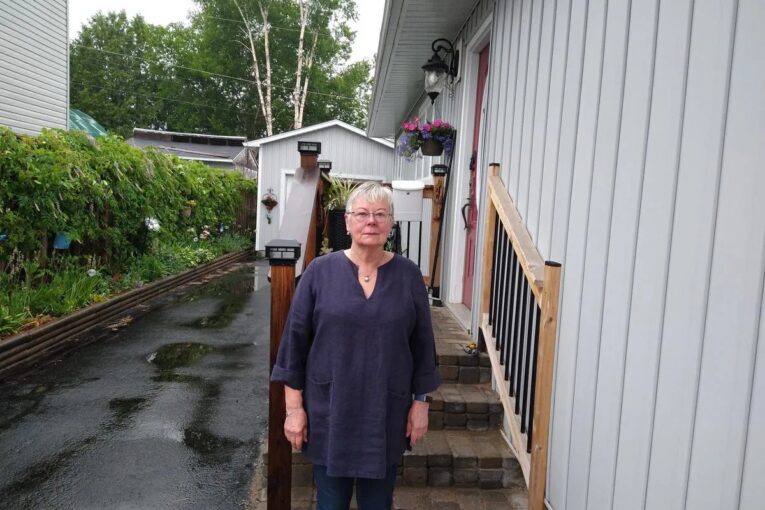
[ad_1]
Federal nuclear regulators say dangerous levels of radiation in and around homes in Elliot Lake, Ont., are not their problem.
The Canadian Nuclear Safety Commission (CNSC) says homeowners are responsible for dealing with the toxic effects of waste rock from nearby uranium mines that was allegedly used as infill on their properties.
The CNSC posted a statement on its website and Twitter feed Tuesday in response to recent media attention about the radioactive waste, first reported by the Investigative Journalism Bureau (IJB) and the Toronto Star.
In the statement, Ramzi Jammal, CNSC’s executive vice-president and chief regulatory operations officer, said his department is only responsible for radioactive substances associated with nuclear energy production and their transportation.
“The materials in question were never chemically processed; they were simply broken up and moved a short distance from their place of origin,” Jammal wrote. “This waste rock is naturally radioactive at levels consistent with the region; it was not subjected to any of the processes of the nuclear fuel cycle.
“For these reasons, CNSC staff assess that this waste rock consists of naturally occurring nuclear substances that are outside of the CNSC’s regulatory authority,” he added.
Jennifer Carling, one of the homeowners in the city north of Lake Huron whose house is above the radioactive waste, called the response “drivel.”
“If this is the standard they’re clearly demonstrating right now, what is going to be happening in the future?” she asked. “If he is so convinced that everything is naturally occurring and safe, I would suggest and invite him to purchase this house for his grandchildren to grow up in.”
The Star/IJB reported that recent testing found residents of four homes in Elliot Lake were being exposed to levels of radiation between eight and 32 times greater than the maximum prescribed by the CNSC.
The effects could stretch to 60 homes, which were moved from the area around the uranium mines into the city of Elliot Lake in the 1960s and allegedly placed on top of radioactive tailings and infill, according to a trove of documents compiled by the Canadian Environmental Law Association.
The CNSC “puts itself out there publicly as a life-cycle regulator of the whole nuclear process and they have a mandate to protect the public and the environment,” said Jacqueline Wilson, one of the association’s lawyers representing the homeowners. “That’s a very important public mandate that is the basis of Canadians’ trust in the nuclear power system and I think this letter undermines that.
“At the end of the day, it is not a homeowner’s responsibility to accept radioactive mine waste on their properties,” she said. “The different federal government entities need to stop passing the buck. Uranium mine waste is radioactive and dangerous … and it needs to be removed from the private property of our clients.”
In response to questions, the CNSC said its mandate is “to regulate the use of nuclear energy and materials” but that it “does not regulate mine waste rock at non-licensed sites.”
Jamie Kneen with MiningWatch Canada said the CNSC relies on a legalistic distinction between “tailings,” which fall under the federal nuclear oversight regime, and “waste rock” that does not.
“Waste rock is anything which is under the cut-off grade for being processed as ore, which is determined by economics, not by chemistry,” he said. “Both have radiation levels well above what you’d expect to find in the Canadian Shield generally.”
In any case, it should be easy to figure out if the houses were built on waste rock, which would be in large chunks, or tailings, which would have been ground up into a fine sand, he said.
Kneen took issue with the CSNC’s claim that “all of the tailings are currently stored and managed” at federally regulated facilities.
“There were piles of tailings around Elliot Lake. Kids used to ride their bikes on them,” he said. “I don’t believe (the CNSC’s claim) that the mines actually maintained all tailings under regulatory control. Maybe in more recent years they were better about it. But certainly in the early days of Elliot Lake, it was not the case.”
After dangerous levels of radiation were discovered in houses in Elliot Lake in the 1970s, the mining companies paid to have fans and venting installed in dozens of homes to funnel radioactive radon gas outside and dig up at least one driveway to remove contaminated rock underneath.
The CNSC says homeowners who received these radiation mitigation systems signed contracts at the time in which they “agreed to be responsible for the long-term care and maintenance of these radon mitigation measures.”
But retirees who moved to Elliot Lake in the 1990s and 2000s say they weren’t told about the radiation, these contracts or even the purpose of the fans when they bought the affected houses.
The federal government had made commitments to remove contaminated soil to at least one homeowner in 2000, according to a series of letters shared with the IJB and the Star.
In Port Hope, Ont., the federal government is currently spending more than $2 billion to have radioactive earth removed and transported to permanent storage facilities.
does not endorse these opinions.
[ad_2]
You can read more of the news on source



